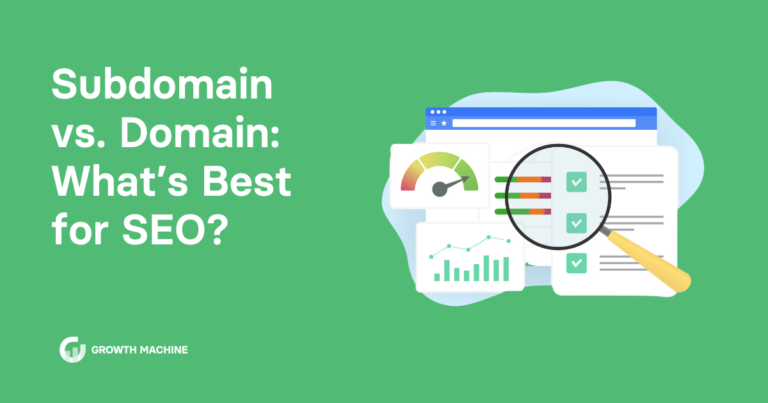4 Proven Keyword Strategies for Triple-Digit Traffic Growth
For brands just getting their feet wet in content marketing, researching and selecting the right keywords can feel a little overwhelming.
What type of content should you write? What monthly search volume is needed to move the traffic dial? What keyword difficulty is attainable for your site? How does domain authority play a role?
There are a number of moving parts to consider when crafting the best strategy and selecting the right list of keywords. Fortunately, there is more than one way to build a successful content marketing strategy.
Driving thousands of organic monthly visitors to your site starts with a solid content marketing strategy that reaches and serves prospective customers, and strengthens brand recognition and authority online.
In this blog post, we’ll look at some of the keyword strategies we’ve used successfully on client sites to build brand awareness and bring in 10x their monthly organic traffic.
What Are Keywords?
Keywords are the words and phrases a brand identifies as those they’d like to be an authority on and rank for on Google and other search engines. They’re essential in content marketing because this is how potential customers find your website or content organically (meaning not through a paid ad).
Often, keywords are obvious descriptors of a brand’s products or services. For example, Growth Machine might want to rank for the search term “SEO agency,” “content marketing agency” and “how to create a optimize my website.”
But good content marketing goes beyond the obvious product and service descriptors and finds other places to meet and serve prospective customers in tangential spaces online.
For example, a remote counselor or therapist whose core offering is online therapy sessions for individuals and couples would obviously be interested in phrases such as “couples counseling,” “how to find the right therapist,” and “best online therapist.”
But, they can also find prospective customers by offering information that serves them in a related space higher in the sales funnel. This therapist might be interested in keywords like “how to improve mental wellness,” “tips for a healthy marriage,” and “signs of anxiety.”
Each of those phrases are considered a keyword, and the person typing these queries could potentially be looking for therapy in the future, providing the therapist with an opportunity to serve them now and build brand awareness and trust.
3 Keywords Variables to Balance
When choosing the best keywords for your brand, there are a few moving parts to balance:
- Keyword Difficulty: KD evaluates how competitive a keyword is and how difficult it will be to organically rank for the keyword on Google based on your site’s domain authority and the quality of your content.
- Monthly Search Volume: MSV refers to the number of times a keyword or phrase is searched each month, based on a rolling 12-month average.
- Domain Authority: DA is a search engine ranking score on a 0-100 scale, developed by Moz, that predicts how easily your site will organically rank on SERPs (or search engine results pages), with 100 being the best possible score and the highest likelihood of ranking. This metric also indicates the number of backlinks a landing page will need in order to rank on the first page of Google.
When crafting your SEO keyword strategy, you’ll need to strike a balance between these three variables. Choose keywords well within your site’s difficultness threshold based on the site’s DA, and make sure there is enough MSV to capture traffic.
If you are new to your content marketing efforts, select low-hanging fruit, or the keywords with the lowest difficulty and highest likelihood to rank for. That way you can begin signaling to Google right out of the gate. These articles will help establish your site and build a foundation of valuable, authoritative content before you move into more challenging keywords later.
Understanding these three variables is imperative to selecting the appropriate keywords for your brand and will help you develop a winning SEO campaign.
4 Proven Keyword Strategies to Try
When it comes to content marketing strategies, what works for one brand, may not move the dial for another, so tracking your KPIs and knowing when to pivot is important. If you’re not sure where to begin, consider one of these four successful strategies we’ve used for brands in a variety of industries and stages in their marketing.
1. The Sales Funnel Approach
In this strategy, you target customers across each stage in the sales funnel. You select relevant keywords with varying levels of conversion intent and serve them with content according to their stage in the funnel.
This approach allows brands to meet potential customers where they are online and nurture them into leads.
Broader, top-of-funnel articles aim to create brand awareness and trust. Content is strictly about educating searchers and providing them with additional resources and articles. The aim is not to sell, but to keep readers engaged in the brand’s content.
For example, a mattress company might target top-of-funnel readers in an article about how to improve sleep by creating a calming night routine. In this article, they would then link to additional resources like “5 Stretches to do Before Bed,” and “The Best Nighttime Tea Recipe.”
Mid-funnel content focuses on nurturing readers into email subscribers (or a similar conversion goal) by providing a solution to their problems and offering further information via a tailored email campaign.
For example, the mattress brand might target the keyword “how to sleep better with back pain” and then encourage these readers to join an email series that teaches subscribers how to ease back pain and sleep better in two weeks.
Similarly, a bottom-of-funnel article for this mattress brand could be “Best Mattress for Back Pain.” Here, searchers are looking for a solution to a specific problem that the brand solves. This article will be more advertorial in nature, teaching readers exactly why their brand is the best solution for this more conversion-focused search query.
When to Use This Keyword Strategy
If your brand is in a competitive online space or requires a longer nurturing process to build brand trust, this strategy can help provide value to readers over a longer research and sales process. The goal is to position your brand as a trusted resource before searchers are ready to make a purchasing decision.
Objective
There is actually a two-pronged objective with this strategy. The first is to increase the site traffic with top-of-funnel, high-volume keywords. And second, is to drive website conversions, newsletter subscriptions, and sales with problem-focused long-tail keywords.
Implementation
Target low-difficulty, high-volume keywords on industry-relevant topics to drive top-of-funnel organic traffic and establish your brand as a trusted resource in your niche.
Select more problem-related queries (i.e., “how to get better sleep,” “sleep positions for neck pain”) to reach middle-of-funnel searchers and offer a more engaging experience with your brand.
Target more conversion-focused, bottom-of-funnel searchers by selecting lower-volume long-tail keywords that are specific to the solutions your brand provides to customer pain points.
Read more about how we grew this FinTech brand’s blog organic traffic by over 6,000% in 13 months using this sales-funnel approach.
2. The ‘Scorched-Earth’ Strategy
The scorched-earth strategy aims to reach potential customers by targeting any and every topic related to the brand’s products and services within an attainable difficultness threshold. You’re effectively blanketing the web with branded content and ensuring that each article is valuable to readers to establish the brand as an industry authority.
For brands in a particularly niche space with hard-to-reach customers, this means going after literally whatever relevant or related keywords you can find and reasonably rank for.
When to Use This Keyword Strategy
If you want to build brand awareness, establish yourself as an authority up against household names, and drive organic traffic in a niche category, this strategy might work for you.
Objective
Get your brand in front of potential customers in a competitive space and drive traffic.
Implementation
Find the places where your competitors are not hanging out, and go there. In many cases, big-name brands have invested their marketing dollars in flashier efforts, leaving the mid-level and low-level long-tail keywords ripe for the taking.
For example, you won’t find the Walgreens and Costco’s of the world investing in content marketing to promote their photo printing services. But that doesn’t mean nobody is looking for these services online.
So how does a small, digital print shop get its name in front of prospective customers? By providing useful resources on related lower-volume, low-difficulty topics.
For example, the brand can target keywords such as “best file resolution for large prints” or “affordable print shop for wedding photos.”
In many cases, broader top-of-funnel keywords have a difficulty that is too high for newer brands to reasonably rank for. Tackling niche keywords that are lower in volume but highly relevant to the brand’s products or services is a worthwhile alternative.
By serving readers when they’re researching a specific, relevant solution to a problem (like not knowing the best resolution for prints), brands can establish themselves as an authoritative resource in the industry, eventually earning the searchers’ business.
This fundraising app’s website grew by over 1,100% in two years by executing a hyper-specific, multi-pronged messaging strategy without relying on high-volume keywords.
3. Competitor Gap Strategy
In this content marketing strategy, brands strive to fill in competitive content gaps by targeting keywords their direct competitors have not (yet) targeted.
For example, an online sock store might perform an analysis and find that competitors are focusing their content efforts on speaking to their unique designs, comfort and wearability, and customizable features.
So what are they not talking about? Perhaps there’s an opportunity to talk about holiday gifting, philanthropic relationships, the quality of material, or how to style socks as part of an outfit.
When to Use This Keyword Strategy
In a saturated industry where the obvious keyword choices pose low probability of ranking, set your brand apart from the competition by meeting potential customers where your competitors are not.
Objective
A competitor gap strategy aims to build brand authority and drive organic traffic by finding relevant places to show off before the competition arrives.
Implementation
Using SEO tools like Ahrefs or SEMrush, perform an analysis to find holes in your competitors’ content strategy that are reasonably attainable given your site’s DA, and relevant to your brand’s products and services.
Start by closely examining what your competitor is doing well. For example, have other sock brands already established themselves as the brand with the quirky designs or customizable features?
Then maybe your brand can emphasize your luxe materials or strategically designed no-slip features.
Knowing what your competitors are doing can help inform a strategy to tackle what they’re not yet doing. Find unique-to-you features to discuss that the competition has not. Or, find new angles to talk about the same customer pain points.
In the planning process for our clients, we often perform a competitive analysis to understand the content trends in their industry. By doing so, we can often unlock unserved or underserved content, queries, and topics their target consumers may be looking for.
For additional brainstorming around the competitor gap strategy, check out these four content marketing tips.
4. Bottom-Up or End User-Focused Content
For brands in the B2B space, your marketing messages are typically geared toward decision-makers at other organizations instead of individuals. But what if you focused your efforts instead on end-users and their needs rather than the brand or organization you’re selling to? The bottom-up strategy allows brands to establish credibility and authority with their customers’ customers, giving their own target audience more reason to buy in.
When to Use This Keyword Strategy
When your B2B content strategy has plateaued or is not delivering the desired results, it might be time to pivot to a less traditional approach.
Objective
Build credibility with the end-users and eventually make your target B2B customers trust your brand, because their customers already do.
Implementation
This strategy involves creating content with your target customers’ customers in mind, providing value to end-users and earning credibility with your prospective customers as a result.
For instance, we created detailed blog articles for this employer branding and university recruiter resource about internships in general and internships at various top tech companies, including how to apply, what to expect, and more. Some topics included:
- How to cold email for an internship
- How long are internships
- Internship at <insert company name>
Which SEO Strategy Will Accelerate Your Brand’s Growth?
There are a number of ways to successfully market your business, and what works for another brand might not work for yours. An effective SEO campaign often involves testing various strategies (and your patience!) and sometimes pivoting to new keywords based on what the data shows.
Content marketing is a big undertaking, but one that can reap huge rewards. We’ve taken dozens of young sites and delivered triple-digit traffic growth, double-digit domain authority growth, and a number of other impressive growth metrics through expert content creation.
With in-depth keyword research, an understanding of the competitive space, and the right metrics tracking in place (like utilizing Google Analytics and Google Search Console), you can create and execute a successful keyword strategy. You’ll build brand awareness and authority, and deliver organic search traffic to your site every week.
If you’re not sure how, or don’t have the manpower to dive into an effective content marketing strategy, contact us and learn more about how we can help you grow your brand.







